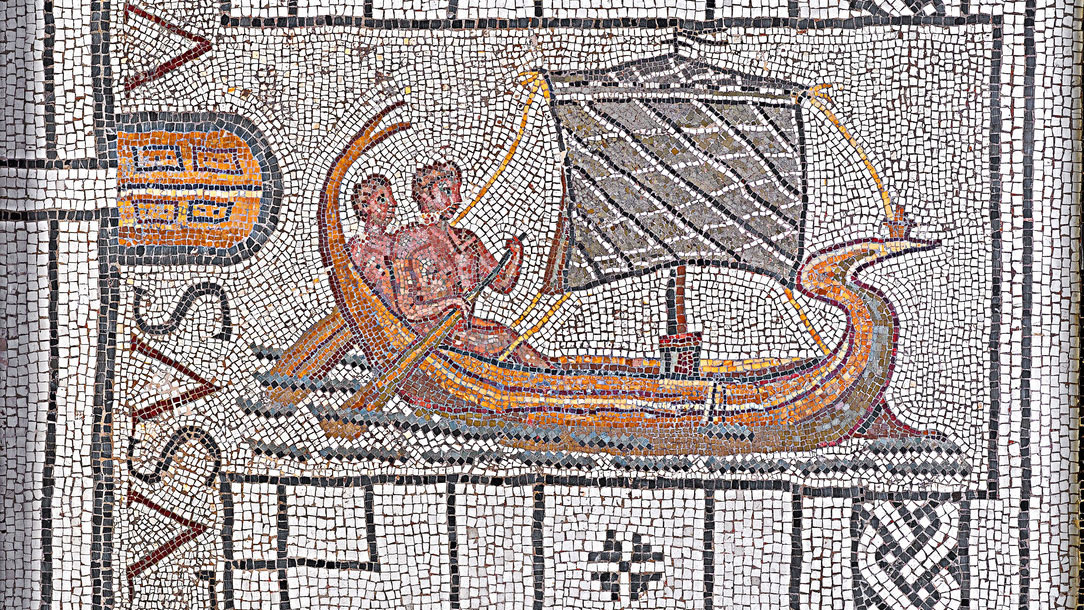Mediterranean Section
The Collections of the Mediterranean Section of the Penn Museum comprise some 34,000 objects of Greek, Roman, Etruscan, Cypriot, and Bronze Age Aegean origins, as well as small numbers of artifacts from related culture areas.

The Collections of the Mediterranean Section of the Penn Museum comprise some 34,000 objects of Greek, Roman, Etruscan, Cypriot, and Bronze Age Aegean origins, as well as small numbers of artifacts from related culture areas.

The classical world and the acquisition of objects from classical lands, especially excavated archaeological material, was a primary interest of the Museum at its founding in 1887 and its formative years. This was a reflection of a general intense interest in classical antiquity in the late 19th and early 20th century in America. This interest was fostered by an educational system that emphasized classical literature and languages, and it was fueled in the 1870s by a fascination with Heinrich Schliemann’s search for Homer’s Troy.
The majority of the objects from excavations sponsored by the Museum were acquired before World War II when the laws governing the export of antiquities from the country of origin made it possible. A large body of archaeological material from Kourion and Lapithos became part of the Museum’s collection with the permission of the Department of Antiquities of Cyprus. Material from Crete, particularly from the site of Gournia, was acquired by the Museum through a permit from the Greek government at the time of excavation. The Roman site of Minturnae, between Rome and Naples, was excavated by the Museum under the direction of Jotham Johnson, and the Museum received a division of the finds.
The collections of the Mediterranean Section include a large number of Greek coins, Roman glass, and nearly 500 bronze reproductions of objects from Pompeii and Herculaneum.
The encouragement and financial support of wealthy donors who supported the Museum and were members of its board, such Lucy Wharton Drexel, Phoebe A. Hearst, and John Wanamaker, made possible many of the important early acquisitions of the Mediterranean Section. These activities were guided by Sara Yorke Stevenson, who became curator of the Museum’s Mediterranean Section in 1894. In 1895, the Museum made an arrangement with Arthur L. Frothingham, Jr., a professor at Princeton University and Associate Director at the American School (later the American Academy) in Rome to serve as an agent for the Museum in sponsoring the work of several Italian excavators and in locating and purchasing antiquities and plaster casts suitable for the Museum’s classical collections. The Frothingham material, particularly the Etruscan tomb groups and the sculpture from the Sanctuary of Diana on the shores of Lake Nemi, shaped the Etruscan and Roman collections immeasurably.
Other objects were donated by individuals who formed sometimes idiosyncratic collections at the end of the 19th and the beginning of the 20th century. Maxwell Sommerville, appointed the first professor of glyptology at the University of Pennsylvania in 1894, left a collection of some 3000 classical engraved gems, amulets and medals. Hermann V. Hilprecht, curator of the Babylonian Section and director of the Museum’s first expedition, to Nippur, Iraq, from 1889 to 1898, collected bronze figurines from Turkey and elsewhere. William Nickerson Bates, a classicist at the University of Pennsylvania from 1895 to 1939, amassed a fine collection of Greek pottery and other artifacts. The Philadelphia siblings John T. and Lydia T. Morris were typical Victorian travelers with eclectic tastes. Most of the Museum’s Greek coins come from John Morris’s collection of ancient coins and glass as well as from Hermann Hilprecht; the major gift of Roman coins came from Robert C. H. Brock around 1898-1899. William Sansom Vaux’s collection of Greek and Roman glass and early travel photographs from the Mediterranean were collected in the 19th century and presented to the Museum as a gift by his great-nephews, George and Henry J. Vaux. An important addition to the Museum’s classical collection in its early years was the gift by John Wanamaker of nearly 500 bronze reproductions, principally of objects from Pompeii and Herculaneum housed at the Naples Museum, which were produced by the famed Chiurazzi foundry in Naples.